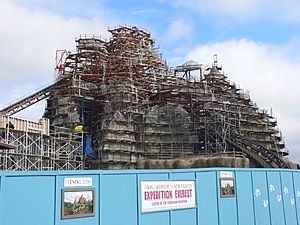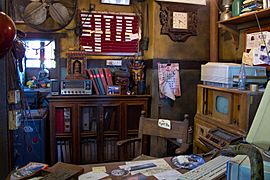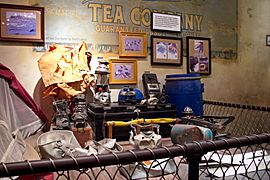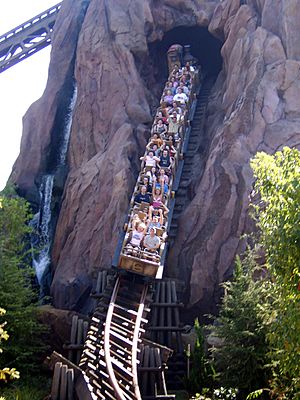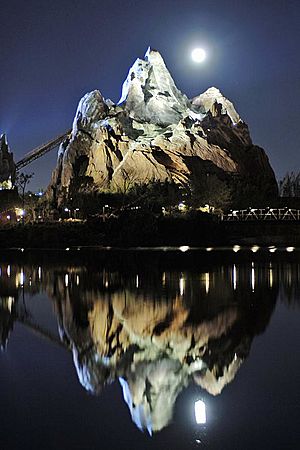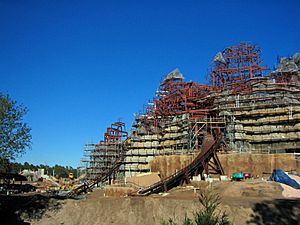Expedition Everest facts for kids
Quick facts for kids Expedition Everest – Legend of the Forbidden Mountain |
|
|---|---|
 |
|
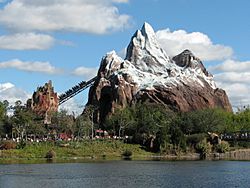
Expedition Everest
|
|
| Disney's Animal Kingdom | |
| Location | Disney's Animal Kingdom |
| Park section | Asia |
| Coordinates | 28°21′29″N 81°35′11″W / 28.358165°N 81.586298°W |
| Status | Operating |
| Soft opening date | January 26, 2006 |
| Opening date | April 9, 2006 |
| Cost | US$100,000,000 |
| General statistics | |
| Manufacturer | Vekoma |
| Designer | Walt Disney Imagineering |
| Model | Custom |
| Track layout | Custom |
| Lift/launch system | Chain lift hill |
| Height | 199.5 ft (60.8 m) |
| Drop | 80 ft (24 m) |
| Length | 4,424 ft (1,348 m) |
| Speed | 50 mph (80 km/h) |
| Inversions | 0 |
| Duration | 2:50 |
| Capacity | 2,050 riders per hour |
| G-force | 3.0 |
| Height restriction | 44 in (112 cm) |
| Trains | 6 (max. 5 in operation) trains with 6 cars. Riders are arranged 2 across in 3 rows with the exception of the last car which has only 2 rows for a total of 34 riders per train. |
| Restraints | Lap-bar |
| Audio-animatronics | Yes (Non-Functional) |
|
|
|
|
|
|
|
|
|
| Expedition Everest – Legend of the Forbidden Mountain at RCDB | |
Expedition Everest – Legend of the Forbidden Mountain is an exciting steel roller coaster found at Disney's Animal Kingdom theme park. This park is part of the Walt Disney World Resort in Florida. The ride is all about the mysterious Yeti who protects the Forbidden Mountain, which is next to Mount Everest.
This roller coaster is the fastest at Disney's Animal Kingdom. It's also the tallest roller coaster at any Disney theme park. For a long time, it was known as the most expensive roller coaster ever built! It cost about US$100 million to plan and build over six years. This record was later broken in 2019. Expedition Everest is also the tallest artificial mountain in all of the Disney Parks.
Contents
Building the Mountain: How Expedition Everest Was Made
Disney first announced this amazing attraction on April 22, 2003. It took three years to build. Workers used a lot of materials, including over 38 miles (61 km) of steel bars and 10,000 tons of concrete.
Expedition Everest first opened for special previews on January 26, 2006. The grand opening was on April 7, 2006. Disney's CEO, Bob Iger, was there to celebrate.
At 199.5 feet (60.8 m) tall, it's the tallest ride at Walt Disney World. Disney keeps all its buildings under 200 feet (61 m) tall. This is because taller structures need blinking red lights for airplanes, which would spoil the magical look of the attractions.
Your Journey: The Ride Experience
Getting Ready: The Queue Line
When you get to Expedition Everest, you can choose from a few lines. There's a regular line, a Fastpass+ line, and a single-rider line. The waiting area is designed to look like a travel agency called "Himalayan Escapes."
As you move through the line, you'll see a replica temple with small holy figures. Then you enter a tea garden. After that, you'll find a room filled with gear from a successful mountain trip. Finally, you reach the "Yeti Museum." This museum teaches you about the Yeti and even shows a huge Yeti footprint! There are about 8,000 real artifacts from Nepal in the museum. If you use the single-rider line, you'll skip most of these cool exhibits.
The Adventure Begins: Riding Expedition Everest
You board the roller coaster in a small village called Serka Zong. Your journey begins as you head into the Himalayas towards Mount Everest.
The train leaves the station and climbs a small hill. Then it goes around a curve and up a big 118-foot (36 m) lift hill into the mountain. As you go up, you pass through a damaged temple. Murals of the Yeti warn you that this mountain is his home.
At the top, the train curves around the main peak and enters a cave. When it comes out, it suddenly stops! The track ahead is torn apart, probably by the Yeti. The train then rolls backwards down a new path that spirals through the mountain.
It stops again in a large cave. Here, you see the Yeti's huge shadow on the wall as he tears up more track. This moment distracts you from a hidden track switch. As the shadow moves away, the train rushes forward out of the mountain. It plunges down an 80-foot (24 m) drop!
The train then makes a sharp 250-degree turn and speeds back into another cave. You hear the Yeti's roars once more! The train exits the mountain and goes through a large loop before being lifted back into the mountain one last time. The train drops through a cave where the Yeti is reaching down towards you. After this final drop, you return to the station. The whole ride lasts 2 minutes and 50 seconds.
The Trains: Your Mountain Vehicle
Expedition Everest has six trains, each designed to look like an old, rusty steam train. They are called the "Anandapur Rail Service." Each train has six cars and can hold 34 riders. You sit two people across in each row.
Riders must be at least 44 inches (112 cm) tall. A lap bar keeps you safe. The "locomotive" part of the train is at the back, not the front. This way, your view isn't blocked! Usually, five trains run at once, but fewer might be used if there aren't many guests. To make it seem like a real steam train, steam comes up from vents under the station when a train arrives.
The Track: A Path Through the Mountains
The steel track for Expedition Everest is 4,424 feet (1,348 m) long. The main lift hill is about 118 feet (36 m) high. This ride was the first to use a new track system from Vekoma, where the rails are on the outside of the ties.
Cool Facts About Expedition Everest
Expedition Everest was the first Disney ride where the trains travel both forward and backward during the same ride! This is possible because of two special track switches.
The mountain, the Yeti figure, and the roller coaster track are all separate structures. They don't touch each other! This was a very complex design challenge.
The Mountain: A Giant Creation
Expedition Everest's mountain is often compared to the Matterhorn Bobsleds ride at Disneyland. Both have snowy mountain settings and an "abominable snowman."
The mountain at Expedition Everest is made from 1,800 tons of steel. It's painted with 2,000 gallons of paint! It is the tallest artificial mountain in the world. However, it's not the tallest point in Florida. This artificial mountain isn't a model of Mount Everest itself. Instead, it's the fictional "forbidden mountain" from the ride's story. Mount Everest is shown as a distant peak in the background, made to look far away using a trick called forced perspective.
The Yeti: A Giant Animatronic
The Yeti figure in Expedition Everest is the biggest and most complex audio-animatronic ever built by Walt Disney Imagineering. It stands 25 feet (7.6 m) tall! Its "skin" is huge, covering 1,000 square feet (93 m2), held on by 1,000 snaps and 250 zippers.
When it works perfectly (in "A-mode"), it can move 5 feet (1.5 m) horizontally and 18 inches (46 cm) vertically. The Yeti's roars are done by a voice actor named Fred Tatasciore.
Sadly, a few months after the ride opened in 2006, the Yeti's structure had a problem. Because of this, it can't move in its full "A-mode" anymore. Now, it operates in "B-mode," where strobe lights flash to make it look like it's moving. Fans sometimes call it the "Disco Yeti." It's very hard to fix because the Yeti is a giant machine inside a finished building. Joe Rohde, the Imagineer who helped create the ride, has said he hopes to fix the Yeti someday.
Promoting the Adventure
Discovery Networks: Exploring the Himalayas
In 2005, Disney, Discovery Networks, and Conservation International worked together to promote Expedition Everest. They went on real expeditions to Nepal. The goal was to do scientific and cultural research in the Himalayas, where the Yeti legend comes from.
These expeditions and the making of the ride were shown in three TV documentaries in April 2006. One show, Building A Thrill Ride: Expedition Everest, showed how the ride was planned and built.
Everest in the City: Times Square Event
On February 15, 2006, Disney did a big publicity event in New York City called "Everest in the City." They put huge billboards on buildings in Times Square. These billboards showed Everest with a roller coaster car speeding down and the Yeti watching. The Yeti's eyes would glow red and flash if you sent a text message to a special number!
Awards and Records
The 2011 edition of Guinness World Records listed Expedition Everest as the most expensive roller coaster in the world. It cost about US$100 million. This record was broken in 2019 by another ride that cost US$300 million.
Expedition Everest also won the 2006 Theme Park Insider Award for the "World's Best New Theme Park Attraction." It has also been ranked highly in other roller coaster polls and awards.
| Golden Ticket Awards: Top steel Roller Coasters | ||||||||||||||||||
|---|---|---|---|---|---|---|---|---|---|---|---|---|---|---|---|---|---|---|
| Year | 2007 | 2008 | 2009 | 2010 | 2011 | 2013 | 2015 | 2016 | ||||||||||
| Ranking | 32 (tied) | 35 | 36 | 36 | 47 | 42 (tied) | 47 | 49 (tied) | ||||||||||
| Mitch Hawker's Best Roller Coaster Poll: Best Steel-Tracked Roller Coaster | |||||||||||||||||||||||||||||||||||||||||||||||||||||||||||||||||||||||||||||||||||||||||||||||||||||||||||||||||||||||||||||||||||||||||||||||||||||||||||||||||||||||||||||||||||||||||||||||||||||||||||||||||||||||||||||||||||||||||||||||||||||||||||||||||||||||||||||||||||||||||||||||||||||||||||||||||||||||||||||||||||||||||||||||||||||||||||||||||||||||||||||||||||||||||||||||||||||||||||||||||||||||||||||||||||||||||||||||||||||||||||||||||||||||||||||||||||||||||||||||||||||||||||||||||||
|---|---|---|---|---|---|---|---|---|---|---|---|---|---|---|---|---|---|---|---|---|---|---|---|---|---|---|---|---|---|---|---|---|---|---|---|---|---|---|---|---|---|---|---|---|---|---|---|---|---|---|---|---|---|---|---|---|---|---|---|---|---|---|---|---|---|---|---|---|---|---|---|---|---|---|---|---|---|---|---|---|---|---|---|---|---|---|---|---|---|---|---|---|---|---|---|---|---|---|---|---|---|---|---|---|---|---|---|---|---|---|---|---|---|---|---|---|---|---|---|---|---|---|---|---|---|---|---|---|---|---|---|---|---|---|---|---|---|---|---|---|---|---|---|---|---|---|---|---|---|---|---|---|---|---|---|---|---|---|---|---|---|---|---|---|---|---|---|---|---|---|---|---|---|---|---|---|---|---|---|---|---|---|---|---|---|---|---|---|---|---|---|---|---|---|---|---|---|---|---|---|---|---|---|---|---|---|---|---|---|---|---|---|---|---|---|---|---|---|---|---|---|---|---|---|---|---|---|---|---|---|---|---|---|---|---|---|---|---|---|---|---|---|---|---|---|---|---|---|---|---|---|---|---|---|---|---|---|---|---|---|---|---|---|---|---|---|---|---|---|---|---|---|---|---|---|---|---|---|---|---|---|---|---|---|---|---|---|---|---|---|---|---|---|---|---|---|---|---|---|---|---|---|---|---|---|---|---|---|---|---|---|---|---|---|---|---|---|---|---|---|---|---|---|---|---|---|---|---|---|---|---|---|---|---|---|---|---|---|---|---|---|---|---|---|---|---|---|---|---|---|---|---|---|---|---|---|---|---|---|---|---|---|---|---|---|---|---|---|---|---|---|---|---|---|---|---|---|---|---|---|---|---|---|---|---|---|---|---|---|---|---|---|---|---|---|---|---|---|---|---|---|---|---|---|---|---|---|---|---|---|---|---|---|---|---|---|---|---|---|---|---|---|---|---|---|---|---|---|---|---|---|---|---|---|---|---|---|---|---|---|---|---|---|---|---|---|---|---|---|---|---|---|---|---|---|---|---|---|---|---|---|---|---|---|---|---|---|---|---|---|---|---|---|---|---|---|---|---|---|---|---|---|---|---|---|---|---|---|---|---|---|---|---|---|---|---|---|---|---|
| Year | 2006 | 2007 | 2008 | 2009 | 2010 | ||||||||||||||||||||||||||||||||||||||||||||||||||||||||||||||||||||||||||||||||||||||||||||||||||||||||||||||||||||||||||||||||||||||||||||||||||||||||||||||||||||||||||||||||||||||||||||||||||||||||||||||||||||||||||||||||||||||||||||||||||||||||||||||||||||||||||||||||||||||||||||||||||||||||||||||||||||||||||||||||||||||||||||||||||||||||||||||||||||||||||||||||||||||||||||||||||||||||||||||||||||||||||||||||||||||||||||||||||||||||||||||||||||||||||||||||||||||||||||||||||||||||||||||
| Ranking |
|
|
|
|
|
||||||||||||||||||||||||||||||||||||||||||||||||||||||||||||||||||||||||||||||||||||||||||||||||||||||||||||||||||||||||||||||||||||||||||||||||||||||||||||||||||||||||||||||||||||||||||||||||||||||||||||||||||||||||||||||||||||||||||||||||||||||||||||||||||||||||||||||||||||||||||||||||||||||||||||||||||||||||||||||||||||||||||||||||||||||||||||||||||||||||||||||||||||||||||||||||||||||||||||||||||||||||||||||||||||||||||||||||||||||||||||||||||||||||||||||||||||||||||||||||||||||||||||||
See also
 In Spanish: Expedition Everest para niños
In Spanish: Expedition Everest para niños


